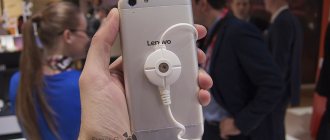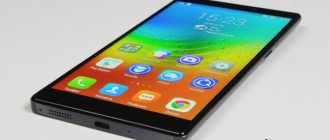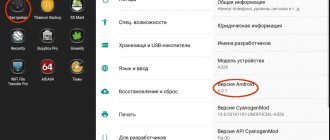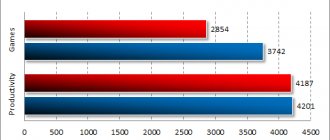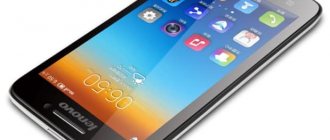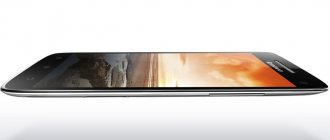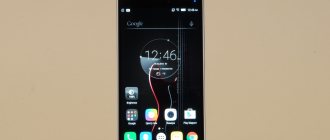People of the 21st century have a special weakness for various hybrids - combinations of several separate, completely independent things into a single whole. Moreover, this happens in absolutely any industry, no matter what. Only a modern person could come up with shampoo-conditioner, three-in-one coffee and Cotops - they would never have thought of this before. There are completely original examples: a couple of weeks ago, BQ-Mobile introduced a phone with a built-in beer bottle opener. For the author of this material, by the way, this is an epoch-making event - he dreamed of such a “mobile phone” since the ninth grade.
Humanity especially loves connecting phones to something. They were successively crossed with laptop computers, game consoles, music players, universal remote controls - you name it, we could go on and on. As a result, this unusual design of a lot of everything in one received the name “smartphone” - and now it won’t surprise anyone. However, smartphone manufacturers still have an unfilled niche. All modern phones are equipped with camera modules - some are completely useless, some are a little better. However, a very rare mobile camera is capable of producing an image close to a photograph from some advanced digital camera.
Therefore, smartphones in which the manufacturer has focused on the camera module are usually classified into a special class - camera phones. Usually, a hint of an advanced camera is already in the name of the device. And if it is not there, then the characteristics of the device will definitely indicate this. The type of camera phones, as we said, is not numerous, but very bright, original, and sometimes even eccentric: just remember how much noise the Nokia Lumia 1020 made with its 41-megapixel camera? How many heated debates were there around the dimensions of the Samsung GALAXY S4 Zoom with 10x optical zoom? It's Lenovo's turn to try to make a camera phone. True, just from its appearance it is clear that Vibe Shot is more of a smartphone than a digital camera. It doesn't have a large lens or an alarmingly high number of megapixels in its specs. Why did Lenovo call its new smartphone a “snapshot”? Let's try to figure it out.
⇡#Appearance and ergonomics
The first thing I want to talk about when it comes to the appearance of the Vibe Shot is the color. The smartphone comes in three colors: classic white and black, as well as black with a very noticeable red edging. It was the latest version that arrived in our test laboratory, which we are probably glad for - in real life this solution looks very original and cool.
Lenovo Vibe Shot – official photo
Modern Lenovo smartphones still do not have their own corporate, established style - the company's designers are clearly in search of the best exterior for their devices. We very, very much support such experiments as a bright red edging along the entire perimeter of the case: we are generally for any variety in a series of similar Android smartphones, otherwise most of them cannot be distinguished from each other at a distance. However, there is one nuance with this beautiful edging: you should never carry a smartphone in the same pocket with keys or coins - they will scratch the paint and thereby expose the metal. This catches your eye, and the pristine beauty of the smartphone is quickly lost.
Lenovo Vibe Shot - front panel
Externally, the smartphone is perceived as a kind of brick: this is facilitated by the very small radius of rounding the corners and the side metal panels polished to a shine. Therefore, you involuntarily begin to think that the Vibe Shot weighs two hundred grams, if not more. However, in reality everything is not so scary - only 145 grams. Your hands don’t get tired from prolonged communication with him. The display here is “only” five inches, which is not much by modern standards. With fingers stretched out due to constant interaction with the “shovels,” it is convenient to work with the gadget without involving the second hand.
Lenovo Vibe Shot - front panel
The front panel here is notable for the fact that at its bottom there are three hardware touch keys - “Menu of open applications”, “Home” and “Back”. They are equipped with backlighting, so there will be no erroneous clicks even in the dark. At the top of the panel there is a peephole for the front eight-megapixel camera and a slot for the earpiece. The front panel of the smartphone is covered with tempered glass Corning Corilla Glass 3, which is resistant to scratches and other minor damage. The glass here has an oleophobic coating, so it’s easy to clean it from fingerprints and other dirt, which, in general, doesn’t really stick to the screen anyway.
Lenovo Vibe Shot – side end
The thickness of the smartphone’s case is small – 7.6 millimeters. This is an “honest” thickness - there are no curves that make the smartphone visually slimmer, and there are no thickenings around the camera.
Lenovo Vibe Shot – side ends
The layout of the Vibe Shot's controls and connectors is quite standard - it's easy to get used to. The Micro-USB interface is located at the bottom end. Next to it are the slots for the external speaker, which is also well located: during use it is not blocked by your hand in either portrait or landscape orientation.
Lenovo Vibe Shot – external speaker
The device's power key is located on the right side, right under the thumb. Next to it are volume control buttons, as well as a physical key to activate the camera and release the shutter. There is also a camera mode switch from automatic to manual and back - this is the first time we have seen this on a smartphone.
Lenovo Vibe Shot – side ends
On the left side there are two connectors: one of them holds two Micro-SIM cards, and the other holds a microSD memory card. Next to it there is a loop through which you can thread a cord to carry the phone around your neck - this is also uncharacteristic of modern smartphones, but it is found everywhere in cameras. The universal 3.5 mm jack for connecting a headset is located at the top end.
Lenovo Vibe Shot – slots for installing SIM and microSD cards
Lenovo designers took a creative approach to the design of the back panel of the Vibe Shot. The panel itself is black, but in its upper part there is a lighter strip on which the main 16-megapixel camera of the device and three multi-colored flash diodes are placed. A very successful stylization of an advanced “digital compact”.
Lenovo Vibe Shot - back panel
But there are also a couple of shortcomings that cannot be ignored. Firstly, the panel is covered with protective glass, and it is easily soiled. It has a grease-repellent coating, but it is not very effective. The panel quickly collects “fingers” and dust, which are very difficult to get rid of - the pristine beauty of the device is quickly lost. Secondly, the camera lens is located too close to the corner of the body. Because of this, if you hold your smartphone in a horizontal orientation - and photos and videos are usually taken in this position - the fingers of your left hand often appear in the frame. A very annoying ergonomic miscalculation for a smartphone designed for photography.
Design
Logically, to begin with the characteristics of the device itself, it is necessary to start with the main and most obvious thing - its appearance. In this matter, “Lenovo Vibe Shot” (reviews confirm this) has something to show.
Let's start with the fact that the phone body combines plastic, metal and glass. Due to this, the device not only has an attractive appearance, but is also well protected in practice, say, from falls, shocks and other third-party influences. Perhaps, taking this into account, a case for the Lenovo Vibe Shot is not required - the phone is already quite durable.
The device is offered for sale in three color modifications - black, gray and red. The difference in their design lies in the color scheme for the metal frame around the perimeter of the case. In all other respects, the model remains unchanged - only in gray the back cover of the smartphone is painted white, and not black (as in all the others).
⇡#Technical characteristics
| Lenovo Vibe Shot | |
| Touch screen | 5 inches, 1080 × 1920 pixels (431.95 ppi), IPS; Capacitive, up to five simultaneous touches |
| Air gap | No |
| Oleophobic coating | Eat |
| Polarizing filter | Eat |
| Protective glass | Corning Corilla Glass 3 |
| CPU | Qualcomm Snapdragon 615 MSM8939 (ARMv8-A): Quad-core ARM Cortex-A53, 1.11 GHz + Quad-core ARM Cortex-A53, 1.65 GHz; Process technology 28 nm; 32-bit and 64-bit computing |
| Graphics controller | Qualcomm Adreno 405, 550 MHz |
| RAM | 3 GB LPDDR3 |
| Flash memory | 32 GB + microSD (~25.5 GB available to user) |
| Connectors | 1 × 3.5mm headset jack; 1 × micro-USB 2.0; 2 × Micro-SIM; 1 × microSD |
| cellular | 2G/3G/4G Dual SIM cards in Micro-SIM format |
| Cellular connection 2G | GSM/GPRS/EDGE 850/900/1800/1900 MHz |
| Cellular 3G | HSPA+ (42.2 Mbps / 5.76 Mbps) WCDMA 850/900/1900/2100 MHz |
| Cellular 4G | LTE Cat. 4 (150 Mbps / 50 Mbps) TDD Band 1/3/7/8/20 FDD Band 40 |
| WiFi | 802.11b/g/n + Wi-Fi Direct |
| Bluetooth | 4.1 |
| NFC | No |
| IR port | No |
| Navigation | GPS, A-GPS, GLONASS, BeiDou |
| Sensors | Illumination, proximity, accelerometer, magnetometer (digital compass) |
| Main camera | 16 MP (5328 × 2997), back-illuminated sensor, Laser autofocus, triple LED flash, Optical image stabilization |
| Front-camera | 8 MP (3264 × 2448), Back-illuminated sensor, no autofocus |
| Nutrition | Non-removable battery: 11 Wh (2900 mAh, 3.8 V) |
| Size | 143 × 70 mm Case thickness 7.6 mm |
| Weight | 145 g |
| Water and dust protection | Absent |
| operating system | Android 5.1 Lollipop Lenovo proprietary shell |
| recommended price | 26,990 rubles |
| Lenovo Vibe Shot – information about the system and hardware according to the CPU-Z application | ||||
⇡#Display
The smartphone has a five-inch screen with a resolution of 1920 × 1080 pixels. The pixel density is high – more than 431 ppi. Of course, there can be no talk of any “pixelization” effect in this case - individual dots on the Vibe Shot display are not visible, no matter how closely you look at the surface of the screen. Fonts, even the smallest ones, look sharp – this display is very easy to read. In general, everything is as usual with 5-inch Full HD devices.
| Lenovo Vibe Shot – Screen Options | ||
The screen is made using IPS technology. Its viewing angles are very wide – no matter which side you look at the display, the information on it is visible without distortion. Even the traditional drop in contrast, characteristic of matrices of this type, is almost imperceptible here. The black on the Vibe Shot screen looks quite deep, even if you look away from the perpendicular.
The display is very responsive: it responds quickly and accurately to touches, and easily detects “gestures”. In total, the device supports up to five simultaneous touches. In the display settings, you can activate a special mode that allows you to use the gadget with gloves.
Lenovo Vibe Shot – AnTuTu MultiTouch Test results
The smartphone has several color profiles, so the user can customize the screen color rendering to suit his tastes and preferences. Here are their names and manufacturer's comments about each mode:
- Default mode – factory standard mode for optimal color;
- True Color – accurate color reproduction, the ability to view photos and images in true color;
- adaptive mode – provides eye protection and is suitable for prolonged use of the phone;
- high brightness mode – the mode increases the level of energy consumption;
- customizable – adjust color temperature and color saturation;
- “outdoor” mode – this mode turns on automatically when the smartphone is outdoors and increases the screen brightness as needed.
| Lenovo Vibe Shot – color settings | ||
Even in standard mode, the brightness reserve of the Vibe Shot screen is very high. The maximum luminosity of the white field is 563 cd/m2. This is a very good result for a mobile IPS matrix, one of the best in our memory. The display has no air gap between the protective glass and the screen; a very effective polarizing filter helps combat glare. In general, there is absolutely no need to use the high-brightness mode - information on the screen and without it is readable in absolutely any conditions; Even in bright sunshine, the display does not glare.
However, if you do activate the high brightness mode, you will get an absolutely incredible 659 cd/m2. But there is one thing: all these candelas will eat the battery very, very willingly. So, we repeat, there is no practical need for this mode. It is noteworthy that Lenovo Vibe Shot is very convenient to use even in the dark. The minimum luminosity of the black field of the display is only 14 cd/m2; in dim light the eyes do not get tired of it. The smartphone is equipped with a light sensor, thanks to which it can independently set the brightness that is comfortable for work at the moment.
With contrast, things are just as good as with brightness - and this can be considered double luck. Usually, when the display has high brightness, the luminosity of the black field automatically rises, which is why the contrast suffers. However, this does not affect the Lenovo Vibe Shot screen in any way. In normal mode, the black field luminosity is only 0.41 cd/m2, in high-brightness mode it is 0.47 cd/m2. On an absolute scale this is just a good result, but since contrast is the ratio of the luminosity of the white and black fields, the result is a very impressive 1400:1.
Lenovo Vibe Shot – Grayscale Color Temperature
The grayscale color temperature of the display floats, which is not good. For dark shades it averages 7250 K and for light shades it drops to 6750 K. On the other hand, the spread is not very large, and both values are close to the reference 6500 K. In theory, the colors on the Vibe Shot screen should look just a little colder than they should, however in practice this is completely unnoticeable. Let us remind you that those for whom this is important can adjust the color temperature of the display in a special section in the settings menu.
| Lenovo Vibe Shot - gray gamma curve (left) and color components (right) compared to the reference curve | ||
In general, all gamma curves are close to the standard curve - there are no cardinal deviations. True, the blue curve is somewhat higher than the ideal one, but it’s also not as bad as some other devices. Again, in theory, this means that blue tones on the Vibe Shot's screen look a little lighter than they should. We were unable to see this - probably only those who have a colorimeter built into their eyes will see it. In general, the display of the Lenovo Vibe Shot smartphone is set up well - its color rendition is quite believable. It also boasts almost record-breaking values for both brightness and contrast. And that's very cool.
Screen
The entire front surface is painted to match the color of the display, which makes it seem like the screen takes up more space than it actually does. Although it is also impossible to say that the phone is equipped with a small display - the characteristics describing the Lenovo Vibe Shot indicate that its size is 5 inches. It operates on the basis of IPS technology, which allows you to transmit colorful images with high accuracy. The image density is enormous - due to the resolution of 1920 x 1080 pixels, it is about 440 dpi. In simple terms, we can say that the model’s screen conveys a very accurate, sharp image, and this is a definite plus.
The developers did not forget about protecting the screen, covering it with special third-generation Gorilla Glass, resistant to mechanical stress.
Judging by the reviews, the Lenovo Vibe Shot phone has both the ability to increase the screen brightness for more convenient work in bright weather and in direct sunlight, and vice versa - to reduce it for a comfortable perception of the image from the display at night and in the absence of lighting . This option is clearly appealing to ordinary users.
⇡#Hardware and performance
It's time to remind our dear reader that the Lenovo Vibe Shot is a mid-price smartphone, and its technical features are appropriate. The smartphone runs on the average Snapdragon 615 system-on-chip in Qualcomm's current lineup. It has eight cores, which undoubtedly appeals to the company's marketers and users who like to count cores, but not their performance. All eight cores here are the same - these are 64-bit ARM Cortex-A53. Four of them operate at 1.1 GHz, the other four at 1.65 GHz. The chip is made using a 28nm process technology
The RAM installed in the device is just like an adult - three gigabytes, and quite fast - LPDDR3. Thanks to this amount of RAM, the smartphone can keep many applications open and, for example, a dozen browser tabs - when switching between them, the page will not need to be refreshed. The smartphone also switches between open applications quite quickly. The volume of built-in flash memory is 32 GB, of which just over 25 GB is available to the user, the rest are reserved by the system. The smartphone has a slot for a microSD memory card up to 128 GB.
In general, synthetic tests testing the processing speed of the cores showed exactly what we expected to see: the performance of the Snapdragon 615 is average. The power of the installed system-on-a-chip is quite enough for solving multimedia tasks (videos in the screen’s native Full HD resolution are played back without problems), for smoothly displaying operating system animations, for web surfing and similar purposes. However, more resource-intensive tasks are difficult for the Lenovo Vibe Shot.
For example, in a simple game task Basemark 2 Taiji, in which modern flagship smartphones are completely stuck at the vSync limit (60 frames per second), Vibe Shot showed only 35.9 FPS. This is a kind of subtle hint that the smartphone will be able to handle 2D casual arcade games, but it will hardly be possible to play heavier games on it. Even if you reduce the graphics settings to a minimum, the picture will twitch, and the smartphone itself will show with all its appearance that it is not intended for toys: under excessive loads, the gadget slows down and noticeably heats up.
The Snapdragon 615 uses a Qualcomm Adreno 405 chip operating at 550 MHz as a graphics controller. Nominally it supports Open GL ES3.0 and DirectX 11.2, that is, the controller is quite modern. It's just not very powerful - the GFXBench 3 and 3DMark Ice Storm Unlimited test results confirm this.
⇡#Camera: introduction, interface, settings
Let's now abstract from all the marketing statements about the Lenovo Vibe Shot and try to judge its camera soberly. The first thing I want to say is that the smartphone nominally has a very serious set of cameras: an eight-megapixel front camera and a main camera with a 16-megapixel sensor. Not bad for a mid-range smartphone, right? By the standards of mid-2015, this is quite a flagship level.
| Lenovo Vibe Shot – front camera options | ||||
The Vibe Shot's front camera doesn't have autofocus, but it does have a number of interesting software features. For example, a smartphone can automatically retouch self-portraits, smoothing out skin unevenness and removing minor blemishes on faces. The result of the transformation, which is important, can be observed in real time even before the image is taken. The degree of retouching depth is determined using a special slider on a scale from one to seven. She works a little aggressively: towards the middle of the scale the face becomes openly childish, and towards the end it turns into a cartoon. The smartphone also has the option of filling the screen with light – yellow or pink. In theory, this should help when taking selfies in the dark: the bright screen will illuminate your face and you can take a photo. The “front camera” here, I must say, is not bad: with its help you can talk to video and take self-portraits even in dim lighting.
Lenovo Vibe Shot – main camera
The rear camera is more interesting. Firstly, it is equipped with laser autofocus, which in theory should be aimed at the subject much faster than traditional, that is, contrast. Secondly, the camera is complemented by a triple LED flash. It would seem, why so many diodes, since even more expensive smartphones get by with a maximum of two? They are needed to take pictures with the correct color balance, so that when shooting with flash, the skin in portraits does not acquire the characteristic “pale-cadaverous” tint. True, despite such a trick on the part of the manufacturer, it can only be used in the most extreme cases: a head-on flash is very bad, regardless of the color of the LEDs. But the presence of optical image stabilization is excellent.
| Lenovo Vibe Shot – viewfinder, settings, camera modes | ||
The camera's viewfinder is simple and friendly. The settings menu in it is done neatly, the headings are supplemented with very informative icons, which eliminates confusion. There are standard options for digital point-and-shoot cameras, such as geotags and horizon lines. There is even an interactive composition tutorial that mostly teaches the rule of thirds, which is well known even to people who are not into photography.
Lenovo Vibe Shot – smart composition
Amateur photographers will likely appreciate the Vibe Shot's advanced manual mode. In it, the user can not only set white balance, ISO sensitivity or the degree of exposure adjustment, but also independently adjust the shutter speed and even focus on the subject. The shutter speed scale, by the way, is quite strange: from 1/15 to 1 second. Why there is no shorter shutter speed is unclear. And, to be honest, the automation does a good job of selecting parameters for shooting. There is no need to set them manually, except that manual focus can be interesting to play with - it is very rare in mobile cameras.
| Lenovo Vibe Shot – “pro camera” mode | ||
Device navigation elements
Despite the originality shown in the design, the arrangement of the phone's batteries remains classic - we can find the same set on other smartphones. So, below the screen, first of all, we see the physical buttons “Home”, “Options” and “Back”, which are equipped with white backlight. Due to this, they look attractive against a dark display.
The remaining keys are located on the right panel. There is a classic set of display lock button and volume control. We also added a button for switching the shooting mode and a button for quickly launching the “Camera” application. It’s not for nothing that the new “Lenovo Vibe Shot” is positioned as a camera phone.
The left side of the device looks empty - slots for installing an additional memory card, as well as a SIM, are placed here. A system of special mines is used, which can be seen on the iPhone. Indeed, convenient and practical.
⇡#Camera: comparison with competitors and example images
All photographs presented in the material were taken in fully automatic mode. It is called very funny - “smart camera”. Manual mode, by the way, has an even more eccentric name: “pro camera.” To evaluate the quality of the Lenovo Vibe Shot's photos, we decided to compare photos from its camera with photos taken on the LG G4. At one time, the 16-megapixel camera of the G-4 made a good impression on us: “... the sharpness of the photographs is high across the entire field of the frame, the decrease in detail towards the edges is minimal. The colors are quite natural, the picture is rich and contrasty - a very good mobile camera,” we wrote about it. And this despite the fact that the LG G4 is positioned as a standard flagship model, and not some kind of camera phone. Each photograph was selected for comparison from a series of four photographs.
| Lenovo Vibe Shot | LG G4 |
In bright daylight, the Vibe Shot's superiority is visible to the naked eye. The photo taken with it turned out to be much more detailed and a little more contrasty. The colors in both photos are quite realistic, but the photo taken with the LG G4 is unacceptably “soft”.
| Lenovo Vibe Shot | LG G4 |
When shooting indoors, the situation was reversed: a more contrasting and detailed image was taken with the G4 camera. Moreover, if you carefully study the photographs, you will notice that the LG has a more, so to speak, voluminous frame. There are no obvious artifacts in the picture taken with Vibe Shot - it’s just objectively somewhat worse (even if it’s not bad in itself). Everything is relative.
| Lenovo Vibe Shot | LG G4 |
Both cameras performed approximately equally well when shooting a printed document. The text looks clear across the entire frame and is easy to read in both photographs. Smartphones selected different shooting parameters (in particular, they set different white balance), but one cannot immediately say that someone did a better job.
| Lenovo Vibe Shot | LG G4 |
Vibe Shot successfully failed shooting in the dark. The G4's photography, of course, is also far from a masterpiece, but at least the LG's photo is not a solid black spot. Here it is, plus high-aperture optics. The G4 lens has a maximum aperture of ƒ/1.8, and the Vibe Shot optics, judging by EXIF data, has a maximum aperture of ƒ/2.2 (in this case, smaller is better).
Lenovo Vibe Shot - sample photos
View all images (5)Overall, the Lenovo Vibe Shot camera turned out to be quite good. Yes, she is afraid of the dark, and her autofocus can be somewhat lost in room lighting. But it handles backlight very well: the software processing of images is well implemented - the automation does its best to prevent highlights or “dips” in the shadows. The resolution of the photographs is very decent, the color rendition is natural. With sufficient lighting, laser autofocus is very quickly aimed at the subject. However, with all this, we cannot say that the main camera of the Vibe Shot is somehow fundamentally different from other mobile cameras. It's definitely good by the standards of modern mobile cameras. Probably one of the best in its class. However, it does not take the quality of images to a fundamentally new level, unlike the already mentioned Nokia Lumia 1020. And since this is the case, then the proud title of camera phone is not for the Lenovo Vibe Shot. Finally, we note that the main camera of the smartphone can record video in Full HD format. A minute of filmed video takes up approximately 140 MB of disk space.
Camera
We have already said that you can judge the emphasis placed on the camera function by the manufacturer by the name of the phone we are describing. This is confirmed by the characteristics describing “Lenovo Vibe Shot”. So, there are two cameras here - front and main. The latter has a strong matrix, the resolution of which is 16 megapixels. This is indicated on the back of the phone, directly opposite the device logo. In addition to strong hardware, manufacturers have also worked on the software basis for interaction with the camera. In particular, the creation of high-quality images is facilitated by the presence of such options as automatic focusing (laser technology is used), a three-tone flash, as well as two modes with a set of their own filters - Auto and Pro.
As the recommendations show, the new “Lenovo Vibe Shot” automatically offers the user a minimum of settings, selecting the conditions for creating the best photo independently. As for the Pro mode, here the photographer can choose the conditions in which the photo is taken and how the composition should look in the future.
The front camera, according to the technical descriptions of the model, has a resolution of 8 megapixels. It’s convenient to take high-quality “selfie” pictures with it. The only caveat is that since there is no autofocus here, you need to take care to move your Lenovo Vibe Shot a short distance away. Only in this case can the camera create a good photo of you and what is located behind you.
⇡#Communication and wireless interfaces
Lenovo Vibe Shot supports dual SIM cards. The device uses Micro-SIM format SIM cards. The slot for the second SIM is individual, not combined with a slot for a memory card - these are becoming less and less common lately, especially on smartphones from China. It’s easy to work with two cards - you won’t get confused with SIM cards. After installing both SIMs in the slots, the smartphone will prompt the user to designate which one to use to make calls, send messages and access the Internet. The call and message logs indicate which card the activity was on. In general, everything is implemented in the same way as in other “dual-SIM” Android smartphones.
Lenovo Vibe Shot - when you lower the “curtain” of the notification panel at the bottom of the screen, it displays which SIM is installed under which number
It is convenient to talk on Vibe Shot - the voice speaker has a fairly high volume reserve, the interlocutor can be heard even in relatively noisy places. The device does not lose connection to the network without obvious reasons - there are no complaints about the quality of signal reception. The device can work in LTE networks, all bands important for Russia are supported - the third, seventh and twentieth. The maximum theoretical data reception speed in mobile networks is 150 Mbit/s, upload speed is 50 Mbit/s (LTE Cat. 4). In reality, as is known, it depends on many factors, such as distances to the base station, network congestion and a number of others.
Lenovo Vibe Shot – SIM card management
The smartphone has a standard set of wireless networks: Wi-Fi and Bluetooth, current version 4.1. The Vibe Shot has neither NFC nor an infrared port for controlling household appliances. If the latter is usually installed only in flagship models, and we won’t complain about its absence, then support for Near Field Communication would definitely be useful here.
| Lenovo Vibe Shot – AndroiTS GPS Test results | ||
The smartphone determines its location using a radio module that can communicate with GPS, GLONASS and BeiDou (Chinese navigation system) satellites. It works quickly and accurately: a few tens of seconds after launching the profile test, the gadget detected a total of nineteen satellites of three navigation systems and was guided by ten of them. The navigation error radius at first fluctuated around 16-20 meters, and then dropped to a completely acceptable 9-11 meters. Lenovo Vibe Shot confidently copes with the role of a car navigator - you won’t get lost with such a pocket assistant.
As a result
Lenovo Vibe S1 is a fairly budget model (compared to its sophisticated “brothers”). At the same time, it looks much more expensive than its cost. This is one of the main advantages of the gadget, so it is perfect as a gift for lovers of beautiful devices. There is also a uniqueness - after all, the first phone with 2 front cameras, even if the pictures they take are not the most perfect.
In terms of functionality, the gadget is average. Average sound, average photo quality, average processor power. No fancy bells and whistles. The battery life is a bit weak for those who are used to hanging out on the Internet and playing games for hours. The gadget cannot be called technically powerful, but for the average average user it is a good budget option. And very stylish.
⇡#Autonomous work
The smartphone has a non-removable 11 Wh battery (2900 mAh, 3.8 V) - for a five-inch smartphone this is quite a good capacity. During testing, the gadget consistently survived until the end of the working day, even under relatively high loads. Two hours in navigator mode, an hour of voice calls, a total of two to three hours of various Internet services - and by the end of the day, the Vibe Shot consistently had 20 to 5% battery charge left. The smartphone adjusted the brightness of the display independently.
In continuous HD video playback mode at maximum screen brightness (with the “default” display profile) with an active Wi-Fi connection and data updating in the background, the device worked for just over seven hours. The result is very, very decent. All you have to do is lower the brightness of the display and you can watch a movie throughout the entire transatlantic flight, even without a break for dinner.
| Lenovo Vibe Shot - Power Saving Options | ||
The smartphone has a power saving mode that disables data transfer in the background. It can turn on automatically when the battery is running low. In addition, the gadget can limit the maximum processor frequency to save energy. Finally, Vibe Shot has an emergency mode that disables all “smart” functions altogether - it will come in handy when it is absolutely impossible to remain without communication for a long period of time.
| Lenovo Vibe Shot - emergency power saving mode | ||
Equipment
When reviewing the Lenovo Vibe Shot, we first came across the packaging of the smartphone. It is made of thick cardboard, has a compact size and at the same time has a minimal amount of information on its surface. After removing the cover, a neatly packaged phone is revealed, located in one section, and additions to it, occupying another part of the free space.
It should be noted that Lenovo Vibe Shot’s equipment as a whole is quite modest. The list of accessories provided by the developer includes a charger, an adapter for European sockets, and a flat USB cable for connecting to a computer. In addition, the manufacturer equipped the box with instructions for the smartphone and a needle for opening the SIM card and microSD slots. If the user wants a case for the Lenovo Vibe Shot, it will have to be purchased separately.

